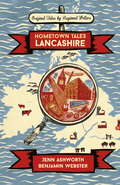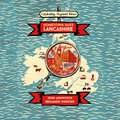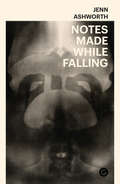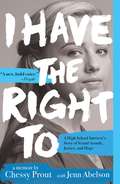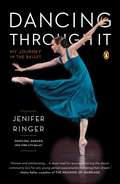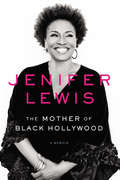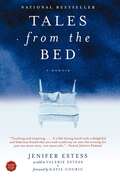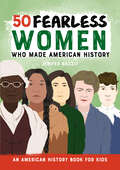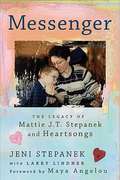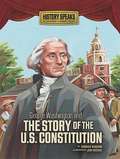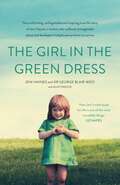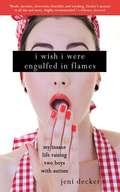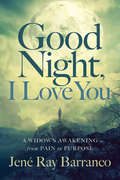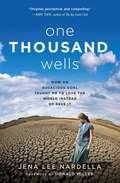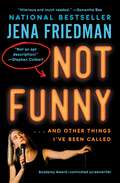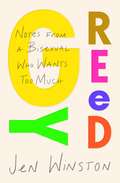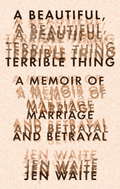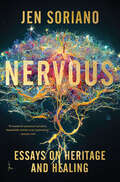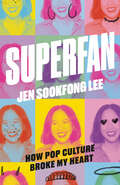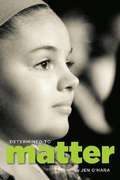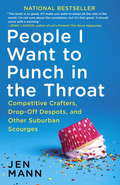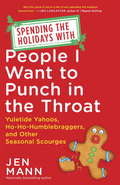- Table View
- List View
Hometown Tales: Lancashire (Hometown Tales Ser.)
by Jenn Ashworth Benjamin WebsterOriginal tales by remarkable writersHometown Tales is a series of books pairing exciting new voices with some of the most talented and important writers at work today. Some of the tales are fiction and some are narrative non-fiction - they are all powerful, fascinating and moving, and aim to celebrate regional diversity and explore the meaning of home. In these pages on Lancashire, you'll find two unique tales. 'After the Funeral, the Crawl' is an arresting portrait of a couple forced to confront a dark secret over the course of a pub crawl one night in Preston, by award-winning novelist Jenn Ashworth. 'JUDAS!' is a vivid, coming-of-age story that traces the political and cultural history of Manchester, from its industrial past to its eventual separation from the county, by Benjamin Webster.
Hometown Tales: Lancashire (Hometown Tales)
by Jenn Ashworth Benjamin WebsterOriginal tales by remarkable writersHometown Tales is a series of books pairing exciting new voices with some of the most talented and important writers at work today. Some of the tales are fiction and some are narrative non-fiction - they are all powerful, fascinating and moving, and aim to celebrate regional diversity and explore the meaning of home. In these pages on Lancashire, you'll find two unique tales. 'After the Funeral, the Crawl' is an arresting portrait of a couple forced to confront a dark secret over the course of a pub crawl one night in Preston, by award-winning novelist Jenn Ashworth. 'JUDAS!' is a vivid, coming-of-age story that traces the political and cultural history of Manchester, from its industrial past to its eventual separation from the county, by Benjamin Webster.
Hometown Tales: Lancashire (Hometown Tales)
by Jenn Ashworth Benjamin WebsterOriginal tales by remarkable writersHometown Tales is a series of books pairing exciting new voices with some of the most talented and important writers at work today. Some of the tales are fiction and some are narrative non-fiction - they are all powerful, fascinating and moving, and aim to celebrate regional diversity and explore the meaning of home. In these pages on Lancashire, you'll find two unique tales. An arresting portrait of a couple coming home to Lancashire, set over a pub crawl one night in Preston, written by award-winning novelist Jenn Ashworth. And, from new voice Benjamin Webster, a vivid coming-of-age story that traces the political and cultural history of Manchester, from its industrial past to its eventual separation from the county.Read by Dean Williamson(p) Orion Publishing Group 2018
Notes Made While Falling (Goldsmiths Press Ser.)
by Jenn AshworthA genre-bending meditation on sickness, spirituality, creativity, and the redemptive powers of writing.Notes Made While Falling is both a genre-bending memoir and a cultural study of traumatized and sickened selves in fiction and film. It offers a fresh, visceral, and idiosyncratic perspective on creativity, spirituality, illness, and the limits of fiction itself. At its heart is a story of a disastrously traumatic childbirth, its long aftermath, and the out-of-time roots of both trauma and creativity in an extraordinary childhood. Moving from fairgrounds to Agatha Christie, from literary festivals to neuroscience and the Bible, from Chernobyl to King Lear, Ashworth takes us on a fantastic journey through familiar landscapes transformed through unexpected encounters and comic combinations. The everyday provides the ground for the macabre and the absurd, as the narration twists and stretches time. Hovering on the edge of madness, writing, it seems, might keep us sane—or might just allow us to keep on living. In Notes Made While Falling, Ashworth calls for a redefinition of the creative work of thinking, writing, teaching, and being, and she underlines the necessity of a fearlessly compassionate and empathic attention to vulnerability and fragility.
I Have the Right To: A High School Survivor's Story of Sexual Assault, Justice, and Hope
by Chessy Prout Jenn Abelson&“A bold, new voice.&” —People &“A nuanced addition to the #MeToo conversation.&” —Vice A young survivor tells her searing, visceral story of sexual assault, justice, and healing in this gutwrenching memoir.The numbers are staggering: nearly one in five girls ages fourteen to seventeen have been the victim of a sexual assault or attempted sexual assault. This is the true story of one of those girls. In 2014, Chessy Prout was a freshman at St. Paul&’s School, a prestigious boarding school in New Hampshire, when a senior boy sexually assaulted her as part of a ritualized game of conquest. Chessy bravely reported her assault to the police and testified against her attacker in court. Then, in the face of unexpected backlash from her once-trusted school community, she shed her anonymity to help other survivors find their voice. This memoir is more than an account of a horrific event. It takes a magnifying glass to the institutions that turn a blind eye to such behavior and a society that blames victims rather than perpetrators. Chessy&’s story offers real, powerful solutions to upend rape culture as we know it today. Prepare to be inspired by this remarkable young woman and her story of survival, advocacy, and hope in the face of unspeakable trauma.
Dancing Through It
by Jenifer RingerA behind-the-curtains look at the rarefied world of classical ballet from a principal dancer at the New York City Ballet In her charming and self-effacing voice, Jenifer Ringer covers the highs and lows of what it's like to make it to the top in the exclusive, competitive ballet world. From the heart-pounding moments waiting in the wings before a performance to appearing on Oprah to discuss weight and body image among dancers, Dancing Through It is moving and revelatory. Raised in South Carolina, Ringer led a typical kid's life until she sat in on a friend's ballet class, an experience that would change her life forever. By the age of twelve she was enrolled at the elite Washington School of Ballet and soon moved to the School of American Ballet. At sixteen she was a professional dancer at the New York City Ballet in Manhattan, home of the legendary George Balanchine and Jerome Robbins. Ringer takes us inside the dancer's world, detailing a typical day, performance preparation, and the extraordinary pressures that these athletes face. Ringer shares exhilarating stories of starring in Balanchine productions, working with the famous Peter Martins, and of meeting her husband and falling in love at the New York City Ballet. Ringer also talks candidly of Alistair Macauley's stinging critique of her weight in his 2010 New York Times review of The Nutcracker that ignited a public dialogue about ballet and weight. She unflinchingly describes her personal struggles with eating disorders and body image, and shares how her faith helped her to heal and triumph over these challenges.
The Mother of Black Hollywood: A Memoir
by Jenifer Lewis<p>From her more than three hundred appearances for film and television, stage and cabaret, performing comedy or drama, as an unforgettable lead or a scene stealing supporting character, Jenifer Lewis has established herself as one of the most respected, admired, talented, and versatile entertainers working today. <p>This “Mega Diva” and costar of the hit sitcom black-ish bares her soul in this touching and poignant—and at times side-splittingly hilarious—memoir of a Midwestern girl with a dream, whose journey took her from poverty to the big screen, and along the way earned her many accolades. <p>With candor and warmth, Jenifer Lewis reveals the heart of a woman who lives life to the fullest. This multitalented “force of nature” landed her first Broadway role within eleven days of her graduation from college and later earned the title “Reigning Queen of High-Camp Cabaret.” <p>In the audaciously honest voice that her fans adore, Jenifer describes her transition to Hollywood, with guest roles on hits like The Fresh Prince of Bel-Air and Friends. Her movie Jackie’s Back! became a cult favorite, and as the “Mama” to characters portrayed by Whitney Houston, Tupac Shakur, Taraji P. Henson, and many more, Jenifer cemented her status as the “Mother of Black Hollywood.” <p>When an undiagnosed menatl illness stymies Jenifer’s career, culminating in a breakdown while filming The Temptations, her quest for wholeness becomes a harrowing and inspiring tale, including revelations of bipolar disorder and sex addiction. <p>Written with no-holds-barred honesty and illustrated with more than forty color photographs, this gripping memoir is filled with insights gained through a unique life that offers a universal message: “Love yourself so that love will not be a stranger when it comes.”</p>
Walking in My Joy: In These Streets
by Jenifer LewisA new offering from the author of the hugely successful Mother of Black Hollywood.Walking in My Joy is a collection of electric stories by the one and only, super hilarious Jenifer Lewis. Her commentary on what’s happening in the world today, told through her outrageous real-life adventures, will have you laughing out loud, while her insightful messages touch your soul.A self-described “traveling fool and nature freak,” Jenifer takes readers with her all over the world, from Cape Town to Bali; Washington, DC, to the Serengeti; Mongolia to St. Petersburg; and Argentina to Antarctica to demonstrate how she walks in her joy by seeking pleasure in everyday encounters. Every step of the way you’ll be doubled over with laughter as she faints at the Obamas’ holiday party; awakens to a swollen face and has to go to the hospital during the height of the Covid pandemic; an alien visitation; a successful takedown of a conman; as well as meeting a handsome Maasai warrior and being chased by a Cape buffalo.An actress, activist, and mental health advocate, Jenifer Lewis imparts ways to love yourself that will allow you to deflect negative energy and keep people who may come to take your joy in check. She stresses the importance of fully living to your greatest ambitions and taking the time to admire the world’s natural gifts. She also encourages embracing each other’s uniqueness as a way of finding societal healing. Walking in My Joy is a riveting and enthralling journey.
Tales from the Bed: On Living, Dying, and Having It All
by Jenifer EstessJenifer Estess is a woman on the verge: She's about to launch her own company; she's looking buff and dating vigorously; she's driving in the fast lane -- with the top down. At the age of thirty-five, Jenifer dreams of falling in love and starting a family. Then she notices muscle twitches in her legs. Walking down a city block feels exhausting. At first, doctors write off Jenifer's symptoms to stress, but she is quickly diagnosed with ALS, a fatal brain disease that is absolutely untreatable. Max out your credit cards and see Paris, suggests one doctor. Instead of preparing to die, Jenifer gets busy. She dreams deeper, works harder, and loves endlessly. For Jenifer, being fatally ill is not about letting go. It's about holding on and reaching -- for family, friends, goals. Jenifer's girlhood pact with her sisters Valerie and Meredith -- nothing will ever break us apart -- guides them as Jenifer faces down one of the most devastating illnesses known to humankind. That same enduring pact inspires the creation of Project A. L. S. , a movement started by the sisters that changes the way science and medicine approach research for ALS and the related diseases Parkinson's and Alzheimer's, and which has already raised more than $18 million. Will Project A. L. S. help scientists discover medicine in time for her?Jenifer answers these questions and others in this beautifully written and wholly inspiring memoir that celebrates a life fuelled by memory. Tales from the Bed forces us to reconsider society's notion of "having it all," and illustrates, more than anything, the importance of endurance, hope, and, most of all, love.
50 Fearless Women Who Made American History: An American History Book for Kids
by Jenifer BazzitDiscover American history through the lives of 50 inspiring women—biographies for kids ages 8 to 12 Women have always been at the forefront of American history—and it's time to hear their astounding stories! This look into American history for kids is bursting with engaging biographies that explore the lives of these influential women from different backgrounds and a wide array of fields. From Revolutionary War soldier Deborah Sampson and abolitionist Harriet Tubman to Hawaiian Queen Lili'uokalani and Supreme Court Justice Sandra Day O'Connor, this engaging guide to American history for kids takes you on a fun and fascinating journey, one fearless woman at a time. Each of these chronologically ordered biographies offers an exciting look into the life and accomplishments of these heroic figures and how they made history. Explore this captivating side of American history for kids with: Incredible stories, incredible women—With multipage biographies that focus on the accomplishments of heroic women, this is what a book about American history for kids should be. Historical timeline—Better understand how each of these women fits into history thanks to timelines that show what else was happening during their lifetimes. Dive deeper—Entries also feature an insightful sidebar that further explains a specific part of the biography, launching you into more learning about American history for kids. Discover the amazing women who helped shape America with this exploration through American history for kids.
Messenger
by Jeni StepanekBy Jeni Stepanek (author) with Larry Lindner (collaborator) An inspiring look at a young man who embodied the best of human nature, touched millions, and worked tirelessly for peace-told through the eyes of the woman who raised him. Oprah Winfrey has called him "an inspiration," Maya Angelou saw him as a kindred sprit and fellow poet, and Jimmy Carter described Mattie Stepanek as "the most remarkable person I have ever known. " When Jerry Lewis received his lifetime achievement award at the Oscars, footage of Mattie played behind him. Five years after his death from a rare neuromuscular disease, Mattie is still being celebrated for his indomitable spirit and message of hope. Now the world will get to know the full story of the poet, the peacemaker, the philosopher, and New York Times bestselling author in the first book to share all of the intimate details of his incredible life. In Messenger, Mattie's mother, Jeni Stepanek, recounts the years before Mattie got sick; how he handled the loss of his siblings from the same disease he had; his decision to spread the message of peace and hope; and how, when he became a celebrity, Jeni helped to keep him grounded, and remember to embrace being a kid. Including never-before- seen poems, journal entries, photos, and correspondence with famous friends, Messengeris an inspirational book about a life lived to the fullest. "Not a day goes by when I don't receive e-mails and letters saying that Mattie's poetry and speeches are not enough-people want to know about him directly and intimately. I am thrilled to have joined with Dutton so that I can now tell all his fans the full story behind my son. " - Jeni Stepanek Good Morning America.
George Washington And The Story Of The U. S. Constitution
by Candice Ransom Jeni ReevesIn 1787, the newly established United States was in trouble. The central government had too little power and too little money. George Washington, Benjamin Franklin, and fifty-three other delegates gathered in Philadelphia, Pennsylvania, to find a way to solve these problems. After more than three months of work, the delegates, led by George Washington, had created the U. S. Constitution. It was finished on September 17, which is now celebrated as Constitution Day.
The Girl in the Green Dress
by Dr George Blair-West Jeni Haynes'I didn't know that you're only supposed to have one personality. I didn't realise that having lots of voices in your head was abnormal. But you are protecting yourself. You are protecting your soul, and that's what I did.'An intelligent, poised woman, Jeni Haynes sat in court and listened as the man who had abused her from birth, a man who should have been her protector, a man who tortured and terrified her, was jailed for a non-parole period of 33 years. The man was her father.The abuse that began when Jeni was only a baby is unimaginable to most. It was physically, psychologically and emotionally sadistic and never-ending. The fact she survived may be called a miracle by some - but the reality is, it is testament to the extraordinary strength of Jeni's mind.What saved her was the process of dissociation - Multiple Personality Disorder (MPD) or Dissociative Identity Disorder (DID) - a defence mechanism that saw Jeni create over 2500 separate personalities, or alters, who protected her as best they could from the trauma. This army of alters included four-year-old Symphony, teenage motorcycle-loving Muscles, elegant Linda, forthright Judas and eight-year-old Ricky.With her army, the support of her psychiatrist Dr George Blair-West, and a police officer's belief in her, Jeni fought to create a life for herself and bring her father to justice. In a history-making ruling, Jeni's alters were empowered to give evidence in court. In speaking out, Jeni's courage would see many understand MPD for the first time.THE GIRL IN THE GREEN DRESS is an unforgettable memoir from a woman who refused to be silenced. Jeni Haynes is an inspiration and her bravery and determination to live is a powerful reminder of the resilience of the human spirit. This is a unique and profoundly important book as it is not only a story of survival, it also includes incredible insight from Dr George Blair-West, Jeni's psychiatrist and an expert in DID.
I Wish I Were Engulfed in Flames: My Insane Life Raising Two Boys with Autism
by Jeni DeckerJeni Decker is five-foot nothing and one hundred and [redacted] pounds-a self described roly-poly, forty-something, Reubenesque bon-bon of a gal, often called cute but never sexy. She has two sons with autism on opposite ends of the spectrum (Jake and Jaxson), a husband who prefers hunting to household chores, an Australian Shepherd named Sugar, and an albino frog named Humbert Humbert. This is her story-a brash, personal, and some-times shocking memoir of one woman's determination to raise two healthy kids with autism and keep her sanity in the process. It's not always easy. Between "poop" incidents, temper tantrums, and the "helpful" advice about parenting from her fellow citizens in the grocery store, Jeni often finds herself wanting to throw something. With chapters like: "Tickling the Weiner," "Why I Hate Pokemon," "Santa: Give it a Friggin' Rest, Already," and "Oprah's the Reason My Kid Thinks I Want to Drown Him in the Tub," I Wish I Were Engulfed in Flames also includes mini-chapters written by her eldest son, Jake.Readers looking for laughter and inspiration will find it here aplenty, along with tons of surreal anecdotes that will have you either shaking your head in disbelief (for those unacquainted with the world of autism) or nodding with recognition (for those who are). As Jeni says, "I developed a new 'normal.'"
Good Night, I Love You: A Widow's Awakening from Pain to Purpose
by Jene Ray BarrancoIn the wake of her husband's abrupt and unexpected death, Jené Ray Barranco was suddenly forced to grapple with being a single mother to three grieving teenagers while feeling a deafening silence at the center of her relationship with God. To cope with her intense heartache, she began writing on a daily basis to create purpose from her pain. GOOD NIGHT, I LOVE YOU compiles those thoughts, and explores with raw and honest prose the author's journey as a widow and shares what she has learned about grief, marriage, parenting, faith, living a meaningful life, and utter dependence on God. Here is a book that will speak to anyone who has ever loved a husband or wife or child.
One Thousand Wells
by Donald Miller Jena Lee NardellaJena Nardella, cofounder of Blood:Water and one of Christianity Today's 33 Under 33, shares how her passion for saving the world grew into a humbler long-term calling of loving the world in all its brokenness in this beautifully written memoir.Ten years ago, Jena Lee Nardella was a fresh-out-of-college, twenty-something with the lofty goal of truly changing the world. Armed with a diploma, a thousand dollars, and a dream to build one thousand wells in Africa, she joined forces with Grammy Award-winning band Jars of Clay to found Blood:Water and begin her mission. Jena's dream for her nonprofit turned that initial $1 into $20, and then $100, and today into more than $25 million. Working throughout eleven countries in Africa, Blood:Water has provided healthcare for over 62,000 people in HIV-affected areas and has partnered with communities to provide clean water for more than one million people in Africa. But along the way she faced many harsh realities that have tested her faith, encountered corruption and brokenness that nearly destroyed everything she'd fought for, and taught her that wishful thinking will not get you very far. Jena discovered that true change comes only when you stop trying to save the world and allow yourself to love it, even when it breaks your heart. With a fresh, intelligent, and winsome voice, Jena Lee Nardella weaves an evocative personal narrative filled with honest and hard-won lessons that demonstrate the amazing things that can happen when you fight for your dreams.
Not Funny: Essays on Life, Comedy, Culture, Et Cetera
by Jena FriedmanNATIONAL BESTSELLER &“In fact very funny.&” —Cosmopolitan &“[A] hilarious and much-needed book.&” —Samantha Bee, Emmy Award–winning comedian, author, and host of Full Frontal with Samantha Bee For fans of the perceptive comedy of Hannah Gadsby, Lindy West, and Sarah Silverman, Academy Award–nominated and acclaimed stand-up comedian Jena Friedman presents a witty and insightful collection of essays on the cultural flashpoints of today.Growing up, Jena Friedman didn&’t care about being likable. And she never wanted to be a comedian, either. A child of the 90s, she wouldn&’t discover her knack for the funny business until research for her college thesis led her to take an improv class in Chicago. That anthropology paper, written on race, class, and gender in the city&’s comedy scene, was, in Jena&’s own words, &“just as funny as it sounds.&” But it did lay the groundwork for a career that has seen her write and produce for The Daily Show with Jon Stewart, the Late Show with David Letterman, and the Oscar nominated Borat Subsequent Moviefilm. Friedman&’s debut collection, Not Funny, takes on the third rails of modern life in Jena&’s bold and subversive style, with essays that explore cancel culture, sexism, work, celebrity worship, and…dead baby jokes. In a moment where women&’s rights are being rolled back, fascism is on the rise, and so many of us could use a breather as we struggle to get by, Jena applies her unique gifts to pull a laugh from things deemed too raw, too precious, and too scary to joke about. She shares her stories of taking on those who told her she was too brash, too edgy, and too &“unlikable&” to make it. She deftly dissects how we get coerced into silence on the issues that matter most, until they&’ve gone too far afield to be turned back around again. And she shares her struggles to make it (-ish) in a world that, more often than not, would rather tune out than listen to a woman confronting the indignities we&’ve been told to bear.
Greedy: Notes from a Bisexual Who Wants Too Much
by Jen WinstonNamed one of the Best Books of 2021 by Oprah Daily, Glamour, Shondaland, BuzzFeed, and more! A hilarious and whip-smart collection of essays, offering an intimate look at bisexuality, gender, and, of course, sex. Perfect for fans of Lindy West, Samantha Irby, and Rebecca Solnit—and anyone who wants, and deserves, to be seen. If Jen Winston knows one thing for sure, it&’s that she&’s bisexual. Or wait—maybe she isn&’t? Actually, she definitely is. Unless…she&’s not? Jen&’s provocative, laugh-out-loud debut takes us inside her journey of self-discovery, leading us through stories of a childhood &“girl crush,&” an onerous quest to have a threesome, and an enduring fear of being bad at sex. Greedy follows Jen&’s attempts to make sense of herself as she explores the role of the male gaze, what it means to be &“queer enough,&” and how to overcome bi stereotypes when you&’re the posterchild for all of them: greedy, slutty, and constantly confused. With her clever voice and clear-eyed insight, Jen draws on personal experiences with sexism and biphobia to understand how we all can and must do better. She sheds light on the reasons women, queer people, and other marginalized groups tend to make ourselves smaller, provoking the question: What would happen if we suddenly stopped? Greedy shows us that being bisexual is about so much more than who you&’re sleeping with—it&’s about finding stability in a state of flux and defining yourself on your own terms. This book inspires us to rethink the world as we know it, reminding us that Greedy was a superpower all along.
A Beautiful, Terrible Thing: A Memoir of Marriage and Betrayal
by Jen Waite“Like Big Little Lies, A Beautiful Terrible Thing is a startling reminder that fairy tales aren’t real. A master class in suspenseful storytelling, Jen Waite recounts the lies, betrayals, and infidelity she endured with unrestrained honesty and deft candor. I couldn’t turn away.”—Jillian Lauren, New York Times bestselling author of Some Girls: My Life in a Harem and Everything You Ever WantedWhat do you do when you discover that the person you've built your life around never existed? When "it could never happen to me" does happen to you?These are the questions facing Jen Waite when she begins to realize that her loving husband—the father of her infant daughter, her best friend, the love of her life—fits the textbook definition of psychopath. In a raw, first-person account, Waite recounts each heartbreaking discovery, every life-destroying lie, and reveals what happens once the dust finally settles on her demolished marriage.After a disturbing email sparks Waite's suspicion that her husband is having an affair, she tries to uncover the truth and rebuild trust in her marriage. Instead, she finds more lies, infidelity, and betrayal than she could have imagined. Waite obsessively analyzes her relationship, trying to find a single moment from the last five years that isn't part of the long-con of lies and manipulation. With a dual-timeline narrative structure, we see Waite's romance bud, bloom, and wither simultaneously, making the heartbreak and disbelief even more affecting.
Nervous: Essays on Heritage and Healing
by Jen SorianoActivist Jen Soriano brings to light the lingering impacts of transgenerational trauma and uses science, history, and family stories to flow toward transformation in this powerful collection that brings together the lyric storytelling, cultural exploration, and thoughtful analysis of The Argonauts, The Woman Warrior, What My Bones Know, and Minor Feelings.The power of quiet can haunt us over generations, crystallizing in pain that Jen Soriano views as a form of embodied history. In this searing memoir in essays, Soriano, the daughter of a neurosurgeon, journeys to understand the origins of her chronic pain and mental health struggles. By the end, she finds both the source and the delta of what bodies impacted by trauma might need to thrive. In fourteen essays connected by theme and experience, Soriano traverses centuries and continents, weaving together memory and history, sociology and personal stories, neuroscience and public health, into a vivid tapestry of what it takes to transform trauma not just body by body, but through the body politic and ecosystems at large.Beginning with a shocking timeline juxtaposing Soriano’s medical history with the history of hysteria and witch hunts, Nervous navigates the human body—centering neurodiverse, disabled, and genderqueer bodies of color—within larger systems that have harmed and silenced Filipinos for generations. Soriano’s wide-ranging essays contemplate the Spanish-American War that ushered in United States colonization in the Philippines; the healing power of an inherited legacy of music; a chosen family of activists from the Bay Area to the Philippines; and how the fluidity of our nervous systems can teach us how to shape a trauma-wise future.With Nervous, Soriano boldly invites us along on a watershed journey toward healing, understanding, and communion.
Superfan: A Memoir
by Jen Sookfong LeeA sharply observed and beautifully intimate memoir-in-pieces that uses one woman's life-long love affair with pop culture as a revelatory lens to explore family, identity, belonging, grief, and the power of female rage. Named a most anticipated book of the year by the Globe and Mail and the Toronto Star.For most of Jen Sookfong Lee's life, pop culture was an escape from family tragedy and a means of fitting in with the larger culture around her. Anne of Green Gables promised her that, despite losing her father at the age of twelve, one day she might still have the loving family of her dreams. Princess Diana was proof that maybe there was more to being a good girl after all. And yet as Jen grew up, she began to recognize the ways in which pop culture was not made for someone like her—the child of Chinese immigrant parents who looked for safety in the invisibility afforded by embracing model minority myths.Ranging from the unattainable perfection of Gwyneth Paltrow and the father-figure familiarity of Bob Ross, to the long shadow cast by The Joy Luck Club and the life lessons she has learned from Rihanna, Jen weaves together key moments in pop culture with stories of her own failings, longings, and struggles as she navigates the minefields that come with carving her own path as an Asian woman, single mother, and writer. And with great wit, bracing honesty, and a deep appreciation for the ways culture shapes us, she draws direct lines between the spectacle of the popular, the intimacy of our personal bonds, and the social foundations of our collective obsessions.
Say More: Lessons from Work, the White House, and the World
by Jen PsakiINSTANT NEW YORK TIMES BESTSELLER Former White House Press Secretary and current MSNBC host Jen Psaki shares the surprising lessons she&’s learned on her path to success and offers unique yet universal advice about how to be a more effective communicator in any situation.Not many White House Press Secretaries capture the nation&’s interest the way Jen Psaki did. Refreshingly candid and clear, Psaki quickly became known for her ability to break through the noise and successfully deliver her message. In her highly anticipated book, Psaki shares her journey to the Briefing Room and beyond, taking you along the campaign trail, to the State Department, and inside the White House under two Presidents. With her signature wit, Psaki writes about reporting to bosses from the hot-tempered Rahm Emanuel to the coolly intellectual Barack Obama to the surprisingly tenderhearted John Kerry. She also talks about her time working closely with President Joe Biden from the start of his administration to set a new tone for the country, restoring a sense of calm and respect for the role of the media in our Democracy. Since leaving the White House, Psaki&’s star has continued to rise. She launched a highly rated show on MSNBC and was so successful that in just six months she was given an additional primetime Monday slot, ahead of Rachel Maddow. And Psaki&’s work doesn&’t end at the office. She is the mother of two young children and shares her stories about the journey of communicating as a parent: During one bedtime briefing, her young daughter asked the question, &“Why do wars start?&”, which Jen carefully explained and then got a follow up: &“Have you ever seen a unicorn?&” In Say More, Psaki explains her straightforward approach to communication, walking you through difficult conversations as well as moments where humor saves the day—whether it is with preschoolers, partners, or presidents. She addresses the best ways to give and receive feedback, how to connect with your audience, how to listen actively, and much more. Say More is the book Psaki wishes she had when she started her career, and is a trove of entertaining, essential lessons from one of the most prominent voices in American politics today.
Determined to Matter
by Dan O'Hara Jen O'HaraShannon O'Hara, skating down the ice chasing after the puck, comes face to face with a larger-than-life opposing team player. Never one to back down from anything, barely five feet fall, Shannon tangles with the player and ends up with a penalty. As she sits in the penalty box-only thinking about getting out in two minutes-no one would ever imagine that this beautiful, vibrant, and competitive young spirit will be gone in 54 days. The devastating news that 12-year-old Shannon is diagnosed with an inoperable brain tumor is unfathomable, surreal, and unimaginable. This is the raw and emotional story of the O'Hara's as they prepare for the fight of their lives, and their ultimate loss.Written and inspired by a blog that Dan and Jen O'Hara wrote to keep in touch with their family, friends, and supporters near and far, the story follows the yearlong battle from diagnosis to death and exemplifies how to live the "new normal" every day, no matter what it entails. Shannon's struggle reveals why family, faith, and hope are so important in our daily lives and how the support of a community plays such a vital role through the good times and especially the bad.
People I Want to Punch in the Throat
by Jen MannA debut collection of witty, biting essays laced with a surprising warmth, from Jen Mann, the writer behind the popular blog People I Want to Punch in the Throat People I want to punch in the throat: * anyone who feels the need to bling her washer and dryer * humblebraggers * people who treat their pets like children Jen Mann doesn't have a filter, which sometimes gets her in trouble with her neighbors, her fellow PTA moms, and that one woman who tried to sell her sex toys at a home shopping party. Known for her hilariously acerbic observations on her blog, People I Want to Punch in the Throat, Mann now brings her sharp wit to bear on suburban life, marriage, and motherhood in this laugh-out-loud collection of essays. From the politics of joining a play group, to the thrill of mothers' night out at the gun range, to the rewards of your most meaningful relationship (the one you have with your cleaning lady), nothing is sacred or off-limits. So the next time you find yourself wearing fuzzy bunny pajamas in the school carpool line or accidentally stuck at a co-worker's swingers party, just think, What would Jen Mann do? Or better yet, buy her book.Advance praise for People I Want to Punch in the Throat "People I Want to Punch in the Throat is so good that it'll make you want to adopt all the cats in the world. I'm not sure about the correlation, but it's that good. It should come with a warning."--Jenny Lawson, author of Let's Pretend This Never Happened "Jen Mann has an amazing way of telling stories that will make you cringe and burst out laughing at the same time. From swinger parties to racist toddlers, she makes the suburbs unbelievably funny."--Karen Alpert, author of I Heart My Little A-Holes "Jen Mann says the things we're all too afraid to say. Her honest and hilarious writing style reminds me of David Sedaris and Tina Fey."--Robin O'Bryant, author of Ketchup Is a Vegetable: And Other Lies Moms Tell Themselves "Jen Mann's shrewd and unrelenting assault on the absurdity of suburban life is an honest peek into the occasional nightmare that is part of living the American dream. I love Jen. I wish she was my neighbor. It's so refreshing to know that I'm not the only one who wants to punch almost everyone in the f***ing throat."--Nicole Knepper, author of Moms Who Drink And SwearFrom the Trade Paperback edition.
Spending the Holidays with People I Want to Punch in the Throat: Yuletide Yahoos, Ho-Ho-Humblebraggers, and Other Seasonal Scourges
by Jen MannFor fans of Laurie Notaro and Jenny Lawson comes an uproarious and oddly endearing essay collection for anyone trying to survive the holidays in one piece. When it comes to time-honored holiday traditions, Jen Mann pulls no punchesIn this hilariously irreverent collection of essays, Jen Mann, nationally bestselling author of People I Want to Punch in the Throat, turns her mordant wit on the holidays. On Mann's naughty list: mothers who go way overboard with their Elf on the Shelf, overzealous carolers who can't take a hint, and people who write their Christmas cards in the third person ("Joyce is enjoying Bunko. Yeah, Joyce, we know you wrote this letter."). And on her nice list . . . well, she's working on that one. Here, no celebration is off-limits. The essays include:* You Can Keep Your Cookies, I'm Just Here for the Booze* Nice Halloween Costume. Was Skank Sold Out?* Why You Won't Be Invited to Our Chinese New Year Party From hosting an ill-fated Chinese New Year party, to receiving horrible gifts from her husband on Mother's Day, to reluctantly telling her son the truth about the Easter Bunny, Mann knows the challenge of navigating the holidays while keeping her sanity intact. And even if she can't get out of attending another Christmas cookie exchange, at least she can try again next year.
